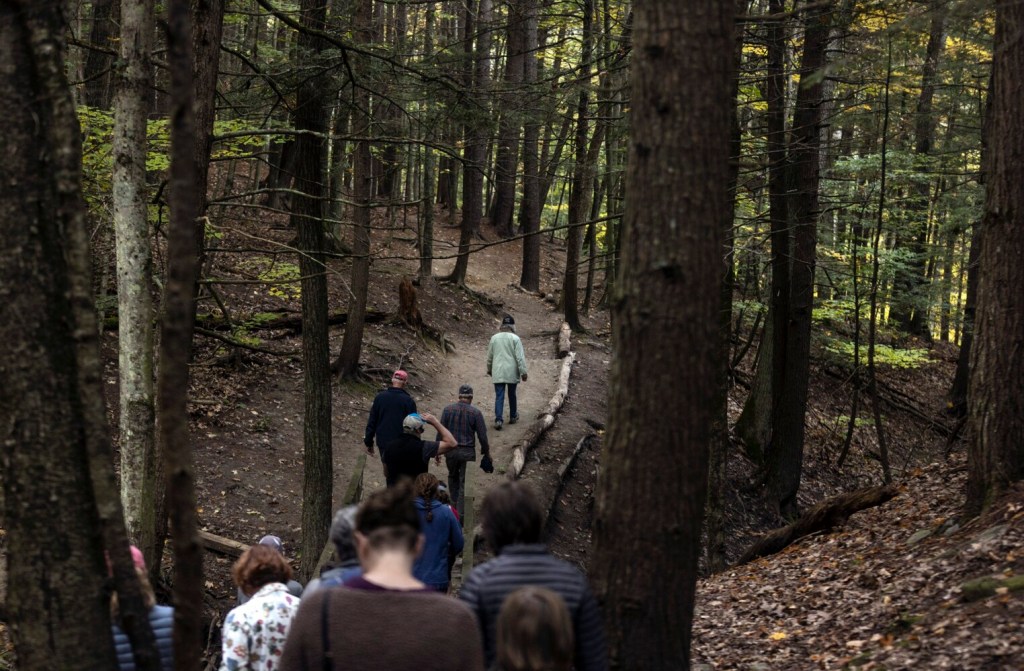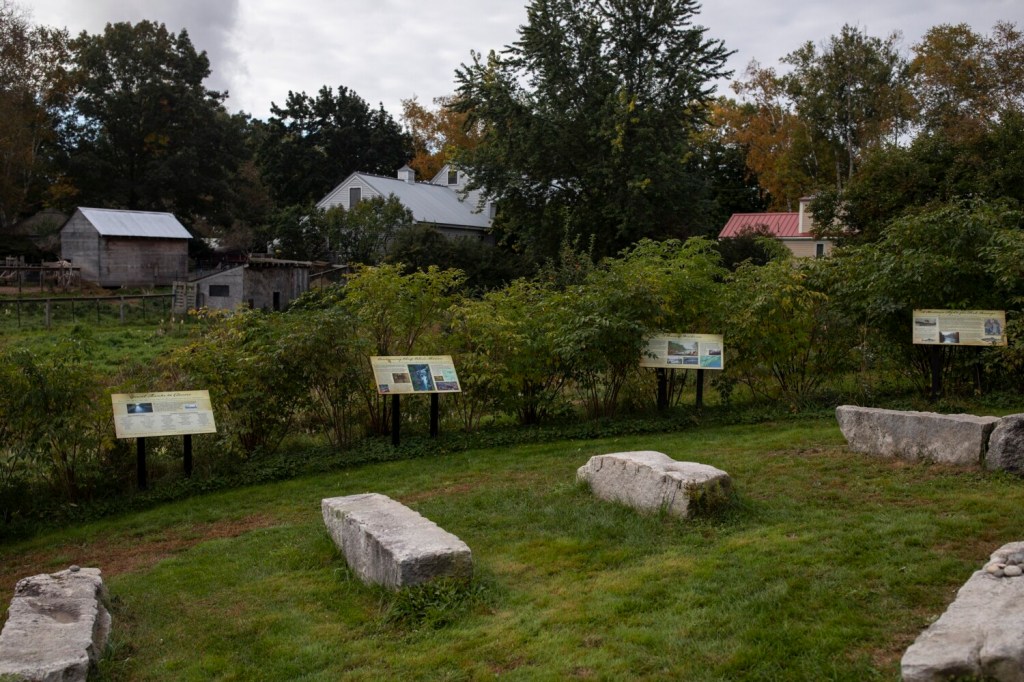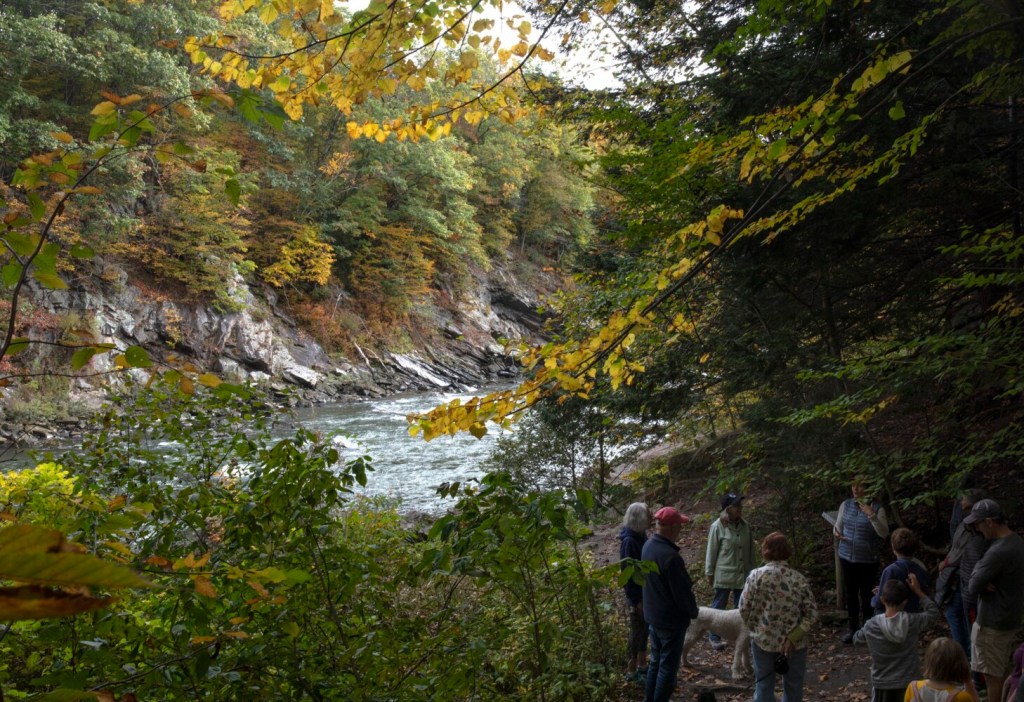Monique and Matt Pines brought their 10-year-old son, Tanner, on a Falmouth Land Trust hike along the Presumpscot River on Indigenous Peoples’ Day because Matt Pines, who is Australian, wanted to learn about Wabanaki history. And the land trust hike that drew 14 others was the only such event they could find on the holiday.
“I’ve lived (in America) for 20 years. I know nothing about pre-colonial history here,” Matt Pines said. “And I think it is so important to not just know a place, but to learn the history of that place – especially for kids to get a deeper connection to the place and to be more rooted to it. And I think the Wabanaki stories help.”
Monday marked the third celebration of the holiday since 2019, when Gov. Janet Mills signed legislation that changed Columbus Day to Indigenous Peoples’ Day. But so far, outdoor cultural and natural history events that teach Wabanaki culture on a day meant to celebrate it are hard to find at many of the state’s 100 or so land trusts.
Wabanaki leaders and some in the conservation community hope and believe that will change.
Donald Soctomah, the historic preservation officer for the Passamaquoddy tribe, called the renaming of the holiday by Mills a positive first step – with others sure to follow.
“I think it’s a good day to reflect, to think about why the name was corrected after so many years,” Soctomah said. “When I was growing up, I knew Columbus Day was something about history that wasn’t right. And people just kept feeding into that history – the wrong history. The more people talk about this, the better an understanding of this there will be. For me, it’s always been Indigenous Peoples’ Day, because every day for me is Indigenous Peoples’ Day – when I have pride in my culture, pride in my people, pride in all the Wabanaki.”
To see a land trust create and host events about Wabanaki history of their own accord, as the Falmouth Land Trust did – without prompting or assistance from tribal leaders – also is a sign of progress, Soctomah said.
“I think that is a powerful example of the public taking the initiative to help the tribes to get this myth of Columbus dispelled,” he said. “It gives me hope for a better relationship in the future. This is the way it should go.”
Darren Ranco, a member of the Penobscot Nation and the University of Maine’s chair of Native American Programs, said in the past few years land trusts have begun talking with Wabanki communities more about the need to offer educational programs. What grew out of that discussion was the First Light learning network, a consortium of tribal leaders and those in the land trust community who are working on better ways to reconnect Wabanaki people with their ancestral land.

Signs provide information about Chief Polin’s fight to preserve the Presumpscot River at a memorial for him in Westbrook. The memorial is on a piece of land donated by Michael Shaughnessy, who is on the board of Friends of the Presumpscot. Brianna Soukup/Staff Photographer
POSITIVE DEVELOPMENTS
First Light focuses on sacred tribal sites and how those sites can come back to the tribes or be used by Wabanaki people in the same ways their ancestors did – collecting sweetgrass, for instance, to make ceremonial artifacts.
“We’ve been working with some key land trusts who have reached out to the tribes,” Ranco said. “They were moved by the fact this is happening in other parts of the country out West. I think these are positive developments.”
Ciona Ulbrich, Maine Coast Heritage Trust’s senior project manager, believes more land trusts eventually will hold outdoor cultural events on Indigenous Peoples’ Day and on other days, too.
Ulbrich, a non-native who helped found First Light, said the network’s chief aim is to increase Wabanaki access to land. “And to bring Wabanaki voices to tables where decisions are made about land,” she said in an email.

Susan Gilpin, a master naturalist, points out where the Smelt Hill Dam was. Gilpin then led a walk along the Presumpscot River to the site of the dam. Hikers learned about the fishery in the river, Wabanaki history and their fight to keep the river a healthy and productive fish habitat. Brianna Soukup/Staff Photographer
Prompted by the work of its Diversity, Equity and Inclusion Committee in the past few years, the Falmouth Land Trust decided to hold two hikes to mark Indigenous Peoples’ Day. For its executive director, Mila Plavsic, who came to the land trust a month ago, holding an event on the day itself to commemorate and teach Wabanaki history was a must.
So the land trust led a hike centered on Wabanaki history along the Presumpscot River in Westbrook on Sunday, and a similar hike along the river in Portland on Monday.
THE STORY OF CHIEF POLIN
Michael Shaughnessy of Westbrook, who is on the board of the Friends of the Presumpscot River, had wanted to do something similar. So he worked with Plavsic to organize Sunday’s walk.
Shaughnessy, who lives along the river, donated some of his property for a memorial to Chief Polin, an Wabanaki chief who spoke out for fish ladders in the river to the governor of Massachusetts before Maine was a state.
“Chief Polin was the first conservation advocate for fish to run up the rivers,” Shaughnessy said.

Mila Plavsic, executive director of the Falmouth Land Trust, walks down to the shore of the Presumpscot River in Westbrook on Monday. Brianna Soukup/Staff Photographer
On Monday’s walk along the Presumpscot in Portland, the land trust’s Susan Gilpin retold Polin’s story – how he twice walked from the Westbrook area to Boston to push for fish ladders, which allow fish to get around obstacles in rivers. She also pointed out flora and fauna – the different kinds of fern, the herring and chad that have run up the river since the Smelt Hill Dam was removed in 2003.
“Some 275 years later,” Gilpin said, “Polin’s work was accomplished.”
Amy Connolly joined Monday’s hike with her daughter Laura because the two had never been along the wide, winding river trail on the Portland side. They enjoyed the mixed forest of conifer, maple and hemlock trees and shades of yellow in the changing foliage. They didn’t know Wabanaki history would be taught. But Laura loved the Penobscot Indian story Plavsic told of a “magical creature” named Gluskabe who tried to help his grandmother catch more fish by luring all the fish in the ocean up a river into a trap. He did it to help his grandmother – but she told him to undo what he’d done.
The conservation message was not lost on Laura, a third-grader.
“I knew it was a myth and not a real story because there is no way he could catch all the fish,” Laura Connolly said. “But even in the tale, when he caught them, he had to let them go.”
Comments are not available on this story.
Send questions/comments to the editors.












